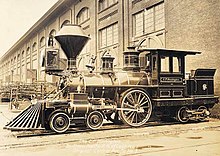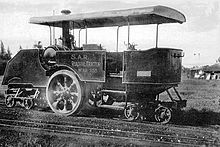4-2-4T
Eight 4-2-4 well- and back-tank locomotives which entered service on the Bristol and Exeter Railway in 1853 appear to have been the first with this wheel arrangement.
The first eight known 4-2-4T locomotives entered service on the broad gauge Bristol and Exeter Railway in 1853 and 1854, numbered in the range from 39 to 46.
They had 9 feet (2,743 millimetres) diameter flangeless driving wheels, supported by leading and trailing two-axle bogies.
These four replacement engines had slightly smaller, 8 feet 10 inches (2,692 millimetres), diameter driving wheels.
Dugald Drummond of the London and South Western Railway built a 4-2-4T F9 class combined locomotive and inspection saloon in 1899.
The single driving axle did not carry the full weight of the engine's rear end due to the trailing truck and, in addition to being too light, it therefore lacked adhesion to reliably pull trains, especially on gradients.
In service, the tractor was often equipped with a water tank tender loaded with additional bags of coal on its running boards.


